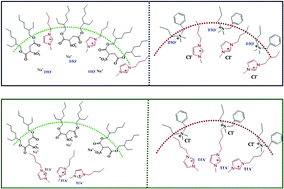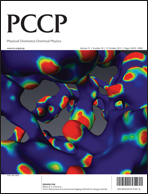Electron donor ionic liquids entrapped in anionic and cationic reverse micelles. Effects of the interface on the ionic liquid–surfactant interactions†
Abstract
The behavior of two ionic liquids (ILs) with high electron donor ability such as 1-butyl-3-methylimidazolium trifluoromethanesulfonate (bmimTfO) and 1-butyl-3-methylimidazolium trifluoroacetate (bmimTfA) entrapped in anionic and cationic reverse micelles (RMs) was investigated using dynamic light scattering (DLS) and FT-IR spectroscopy. The systems studied were chlorobenzene/sodium 1,4-bis-2-ethylhexylsulfosuccinate (AOT)/bmimTfO, chlorobenzene/AOT/bmimTfA, chlorobenzene/benzyl-n-hexadecyldimethylammonium chloride (BHDC)/bmimTfO and chlorobenzene/BHDC/bmimTfA. DLS results reveal the formation of RMs containing bmimTfO and bmimTfA as polar components since the droplet size values increase as Ws (Ws = [IL]/[surfactant]) increases. To the best of our knowledge this is the first report where it is shown that both ILs are entrapped by AOT and BHDC surfactants to effectively create RMs. Furthermore, it is shown that the RMs consist of discrete spherical and non-interacting droplets of IL stabilized by the surfactants. The larger droplet size values and the larger changes obtained for bmimTfO entrapped in AOT and BHDC RMs in comparison with those for bmimTfA in both RMs can be explained considering the different IL–surfactant interactions. The FT-IR results suggest that the ionic interactions (with the surfactant polar head groups, surfactant counterions or with the IL counterions) are substantially modified upon confinement. These interactions produce segregation of ILs's ions altering the composition of the RM interfaces. These facts show the versatility of this kind of organized systems to alter the ionic organization, information that can be very important if these media are used as nanoreactors because unique microenvironments can be easily created simply changing the RM components and Ws.


 Please wait while we load your content...
Please wait while we load your content...